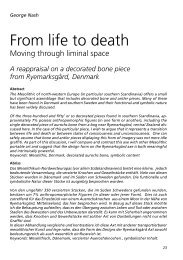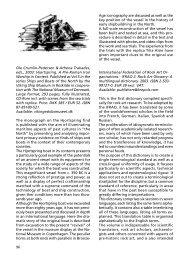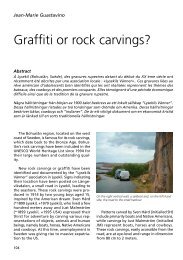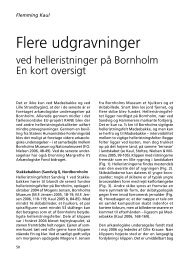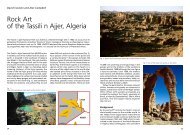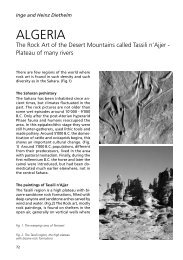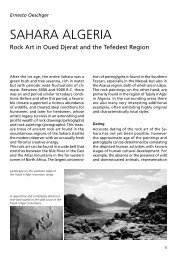Udgravninger ved helleristninger
Udgravninger ved helleristninger
Udgravninger ved helleristninger
You also want an ePaper? Increase the reach of your titles
YUMPU automatically turns print PDFs into web optimized ePapers that Google loves.
ecause already before then the rock had<br />
been sanctified through ritual acts.<br />
Perhaps we can observe how natural features<br />
of the landscape were gradually transformed<br />
into cultural monuments: from nature to culture.<br />
Crevices and hollows of the rock were<br />
filled up with material of a different kind,<br />
rock carvings were made, fire was kindled,<br />
fences and walls were built, stones were<br />
packed together and stone pavements were<br />
laid and, in some cases, parts of the rock were<br />
covered or hidden by stones. The rock carvings<br />
were only one part, albeit a significant<br />
one, of a long ritual process.<br />
A recurring feature at the rock carving sites<br />
is the depositing of burnt clay. Often the clay<br />
lumps are more or less round, and imprints<br />
of withies or planks are rare. The pieces do<br />
not have the flat appearance of clay-daubing<br />
fragments belonging to houses. This<br />
has given rise to speculation whether the<br />
pieces of burnt clay were made for, or were<br />
used in, some kind of rituals. However, at<br />
Madsebakke, the best pieces of burnt clay<br />
are certainly rather flat pieces with clear<br />
imprints of withies and planks, real fragments<br />
of wattle-and-daub. Even though at<br />
Madsebakke these fragments must have belonged<br />
to houses, they do not necessarily<br />
reflect the existence of houses at the site<br />
itself. The wattle-and-daub, deliberately<br />
deposited together with stones, may have<br />
been collected elsewhere.<br />
It is a striking fact that what is deposited at<br />
the rock carving sites, such as burnt clay, is<br />
of little material value. No huge offerings of<br />
valuable gold or bronze objects have been<br />
found at the rock carving sites themselves.<br />
But in some cases substantial votive offerings<br />
have been found in the vicinity of rock<br />
carving sites, which means within a distance<br />
of 1-2 km. The most intriguing example is<br />
the large rock, or rather the little mountain,<br />
called Fluberget, near Stavanger, southwest<br />
Norway. Here in a large bog in front of<br />
this significant rock two flint daggers were<br />
found, one of them from the Early Bronze<br />
Age, along with three bronze swords, one<br />
of them imported from Central Europe, a<br />
bronze arm ring and, last but not least, the<br />
finest pair of bronze lurs in all Norway. In<br />
this case it was probably the ‘holy mountain’<br />
itself that was the key feature, while the<br />
votive deposits as well as the rock carvings<br />
were both secondary features, but indeed<br />
ones related to that conspicuous rock. In<br />
general terms, there is a field of landscape<br />
archaeology to be further developed here,<br />
where studies of the situation of rock carvings<br />
in relation to votive deposits, ‘intervisibility’<br />
and natural features should provide<br />
interesting results.<br />
Thus, it has been demonstrated that the rock<br />
carvings are parts of a larger context, where<br />
finds from both closer and more distant surroundings<br />
should be taken into account. The<br />
surroundings of the rock images, including<br />
crevices in the rocks themselves are crowded<br />
with interesting finds. Not only the rock carvings<br />
themselves are of great antiquarian<br />
value, but also the areas around the rock<br />
carvings hold evidence which needs further<br />
protection, evidence which can contribute<br />
to our better understanding of human ritual<br />
behaviour over thousands of years..<br />
Excavations outside Scandinavia have also<br />
been carried out with interesting results.<br />
By a stone with cup marks at Mulsum near<br />
Bremervörde, Niedersachsen, Germany, a<br />
layer around was dug away, and here a large<br />
ring of fire was lit. Some field stones, and<br />
pots were deposited. A Carbon 14 sample<br />
dated the fire to 770-395 BC.<br />
The most interesting excavation results are<br />
from Valcamonica, Northern Italy. Here, at<br />
the rock carving sites at Cemmo, near the<br />
village of Capo di Ponte, a semicircular stone<br />
wall enclosing two vertical rock carvings was<br />
unearthed in the course of a recently completed<br />
excavation project. The carvings are<br />
seen on the vertical faces of two large rocks.<br />
The motifs include lines of animals and of<br />
daggers with triangular blades. These daggers<br />
are of the Copper Age ‘Remedello’ type,<br />
which can be dated to around the middle of<br />
the third millenium BC (Fig. 5).<br />
The stone wall delimiting the sacred area<br />
in front of the rock carvings was probably<br />
47



